For the past 20 years, Indian artists have had to watch in envy as foreign buyers showered recognition and cash on their Chinese peers.
But after years of institutional neglect, they finally seem to be getting the support they need to push their work on an international market that has traditionally focused on established artists in East Asia.
Last week saw the biggest-ever gathering of contemporary galleries in the country with the four-day India Art Summit, which aims to establish itself alongside other shows such as the now well-known Shanghai art fair.
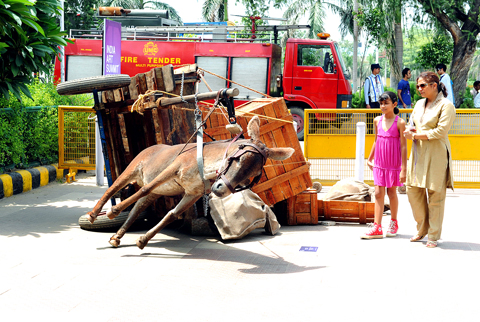
PHOTO: AFP
“This is just the beginning. The summit is still growing, just like Indian contemporary art,” said Neha Kirpal, associate director of the event.
Like other experts, Kirpal concedes that China is “way ahead” of India in terms of the development of its art market.
Last year, the first edition of the summit had three international galleries. This year 17 participated despite the slowdown, Kirpal said.
But for Indian artists to reach a bigger audience, industry insiders say the supporting infrastructure must be improved — a common problem in all areas of life in India.
Art schools, galleries, museums and public funds are all lacking.
“Can anybody enlighten me about the government’s role in promoting art?” said Dadiba Pundole, owner of the Pundole art gallery in Mumbai, one of India’s oldest galleries. “They have failed miserably and it is only the private players that have kept the scene alive.”
There are just a handful of prominent galleries in India for thousands of artists and only a few crumbling museums, built between 1910 and 1920 by the British.
“The total number of art schools can be counted on one’s fingertips,” Kirpal said.
Yamini Mehta, director of modern and contemporary Indian art at the Christie’s auction house in London, says the Indian art business is gathering momentum, but the absence of institutional support is a problem.
“There has not been much institutional support and resources for the visual arts in India as there has been in China,” Mehta said.
She says the Chinese authorities have promoted the arts heavily since the 1980s to compensate for the loss of creativity during the Cultural Revolution of the 1960s.
Unlike Chinese art, much of the work by Indians is still bought by Indians, making the market inward-looking and limiting its development internationally.
“Most Indians buy indigenous works, which is a good way to start collecting art, but gradually Indian art has to step out of its own borders for wider acceptance,” said Stefan Wimmer from the Beck & Eggling art gallery in Germany, which had a display at the art summit.
The rise of India’s business elite is also creating a class of people ready to splash cash on domestic art, promising a brighter future for local artists.
“There are the fixed [established] clients and there are the new clients who have invested in houses, cars, jewelry but are looking for more. Art is their preferred choice,” says Shilpa Dugar of Krishala Arts, a gallery based in Chennai.
For now, prices for Indian art are off the highs reached in 2002 to last year, when international auction houses recorded record sales for the country’s celebrated artists M.F. Husain, F.N. Souza, S.H. Raza or Satish Gujaral. The market has fallen sharply, spelling bad news for some Indian galleries, particularly those that overstretched themselves during the boom years such as Bodhi, which has shut many of its international spaces.
“Indian art had become too pricey till last year. This year everyone is happy to reduce the prices by 25 to 30 percent,” an Indian art buyer who refused to be named told reporters.
Indian artists must also contend with constraints on their freedom of expression, a right guaranteed under the Indian Constitution but one that has been under attack from religious extremists.
The country’s most acclaimed painter was conspicuous by his absence at last week’s event because of fears for his security.
M.F. Husain, 94, has angered hardline Hindus by portraying Hindu deities in the nude or in a sexually suggestive manner, and his work and home have been attacked.
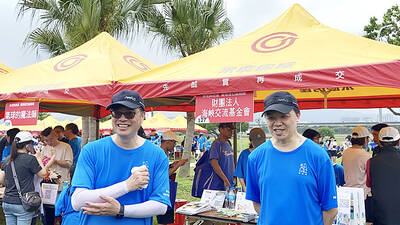
SECURITY: As China is ‘reshaping’ Hong Kong’s population, Taiwan must raise the eligibility threshold for applications from Hong Kongers, Chiu Chui-cheng said When Hong Kong and Macau citizens apply for residency in Taiwan, it would be under a new category that includes a “national security observation period,” Mainland Affairs Council (MAC) Minister Chiu Chui-cheng (邱垂正) said yesterday. President William Lai (賴清德) on March 13 announced 17 strategies to counter China’s aggression toward Taiwan, including incorporating national security considerations into the review process for residency applications from Hong Kong and Macau citizens. The situation in Hong Kong is constantly changing, Chiu said to media yesterday on the sidelines of the Taipei Technology Run hosted by the Taipei Neihu Technology Park Development Association. With
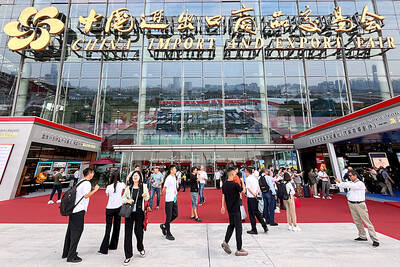
CARROT AND STICK: While unrelenting in its military threats, China attracted nearly 40,000 Taiwanese to over 400 business events last year Nearly 40,000 Taiwanese last year joined industry events in China, such as conferences and trade fairs, supported by the Chinese government, a study showed yesterday, as Beijing ramps up a charm offensive toward Taipei alongside military pressure. China has long taken a carrot-and-stick approach to Taiwan, threatening it with the prospect of military action while reaching out to those it believes are amenable to Beijing’s point of view. Taiwanese security officials are wary of what they see as Beijing’s influence campaigns to sway public opinion after Taipei and Beijing gradually resumed travel links halted by the COVID-19 pandemic, but the scale of
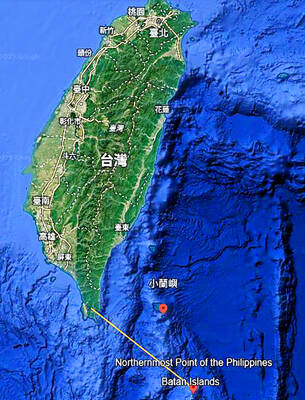
A US Marine Corps regiment equipped with Naval Strike Missiles (NSM) is set to participate in the upcoming Balikatan 25 exercise in the Luzon Strait, marking the system’s first-ever deployment in the Philippines. US and Philippine officials have separately confirmed that the Navy Marine Expeditionary Ship Interdiction System (NMESIS) — the mobile launch platform for the Naval Strike Missile — would take part in the joint exercise. The missiles are being deployed to “a strategic first island chain chokepoint” in the waters between Taiwan proper and the Philippines, US-based Naval News reported. “The Luzon Strait and Bashi Channel represent a critical access
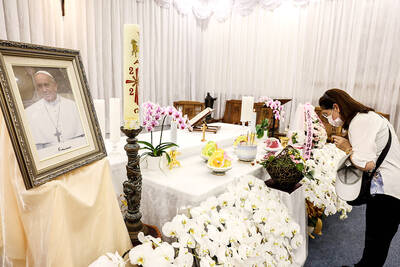
Pope Francis is be laid to rest on Saturday after lying in state for three days in St Peter’s Basilica, where the faithful are expected to flock to pay their respects to history’s first Latin American pontiff. The cardinals met yesterday in the Vatican’s synod hall to chart the next steps before a conclave begins to choose Francis’ successor, as condolences poured in from around the world. According to current norms, the conclave must begin between May 5 and 10. The cardinals set the funeral for Saturday at 10am in St Peter’s Square, to be celebrated by the dean of the College